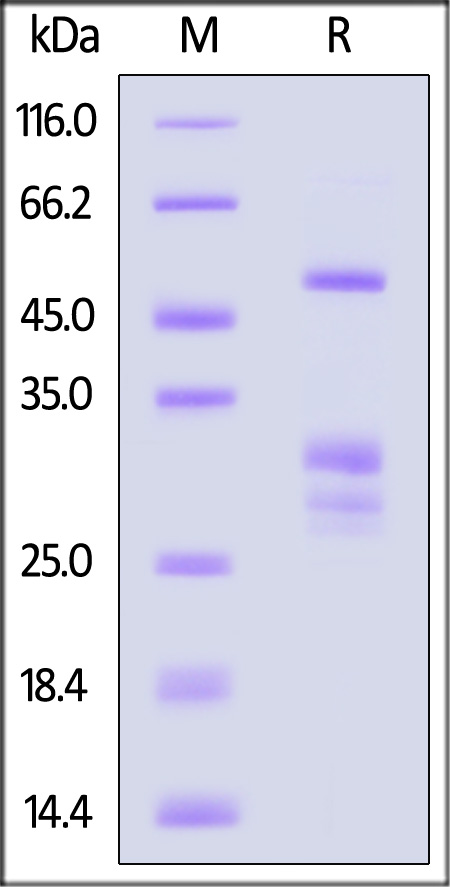分子别名(Synonym)
HSP90AA1,HSP90A,HSP 86,HSP86,HSPC1,HSPCA,EL52,HSP89A,HSP90N,HSPCAL1,HSPCAL4,HSPN,Hsp89,Hsp90,LAP2
表达区间及表达系统(Source)
Human HSP90AA1, GST Tag (HS1-H513x) is expressed from E. coli cells. It contains AA Glu 535 - Asp 732 (Accession # NP_005339).
Predicted N-terminus: Met
Request for sequence
蛋白结构(Molecular Characterization)

This protein carries a GST tag at the N-terminus.
The protein has a calculated MW of 49.3 kDa. The protein migrates as 27 kDa,29 kDa,31-32 kDa and 47-49 kDa under reducing (R) condition (SDS-PAGE).
内毒素(Endotoxin)
Less than 1.0 EU per μg by the LAL method.
纯度(Purity)
>85% as determined by SDS-PAGE.
制剂(Formulation)
Lyophilized from 0.22 μm filtered solution in 50 mM HEPES, 150 mM NaCl, pH7.0 with trehalose as protectant.
Contact us for customized product form or formulation.
重构方法(Reconstitution)
Please see Certificate of Analysis for specific instructions.
For best performance, we strongly recommend you to follow the reconstitution protocol provided in the CoA.
存储(Storage)
For long term storage, the product should be stored at lyophilized state at -20°C or lower.
Please avoid repeated freeze-thaw cycles.
This product is stable after storage at:
- -20°C to -70°C for 12 months in lyophilized state;
- -70°C for 3 months under sterile conditions after reconstitution.
电泳(SDS-PAGE)

Human HSP90AA1, GST Tag on SDS-PAGE under reducing (R) condition. The gel was stained with Coomassie Blue. The purity of the protein is greater than 85%.
背景(Background)
Heat shock protein HSP 90-alpha (HSP90AA1 or HSP90A) is also known as Heat shock 86 kDa (HSP 86 or HSP86), Renal carcinoma antigen NY-REN-38, HSPC1, HSPCA, EL52, HSP89A, HSP90N, HSPCAL1, HSPCAL4, HSPN, Hsp89, Hsp90, LAP2, which belongs to the heat shock protein 90 family. HSP90AA1 undergoes a functional cycle that is linked to its ATPase activity. This cycle probably induces conformational changes in the client proteins, thereby causing their activation. HSP90AA1 interacts dynamically with various co-chaperones that modulate its substrate recognition, ATPase cycle and chaperone function.























































 膜杰作
膜杰作 Star Staining
Star Staining











